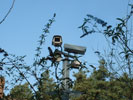What security options work best in complexes and estates?November 2009 Just as comprehensive security is key in freestanding homes, so too do these same rules apply to those living in estates and complexes. People need integrated security systems that offer them peace,
happiness and wellbeing, rather than traditional burglar alarms which simply signal the presence
of an intruder inside their home. According to Elvey Security, security is all about the right mixture of flexibility and functionality that meet homeowners’ needs. Moreover, security encompasses more than crime issues; it also focuses on home safety issues.
Systems need to be expandable so that future requirements can be accommodated. They should also be able to switch lights on and off, allow for video verification at the central station, have built-in false alarm prevention features, and can auto-arm when the owner forgets to do so on leaving the property. Ideally, they should be able to warn when swimming pool areas have been breached or gates exited, in the interests of protecting small children.
Multipartition features and the ability to distinguish between external and internal intrusions with different sounding alarms are also desirable features, as is the capability of sending a duress signal in the event that the owner is over-powered and ordered to disarm the system. Finally, systems should be supported by auxiliary power supplies that support the uninterrupted functioning of keypads and detectors when the main fuse is damaged.
Perimeter security
Protection starts at the perimeters where intruders can be detected long before they gain access to the home. Today, people are able to safeguard and monitor their perimeter barriers with state-of-the-art technology such as photoelectric detectors that allow them freedom of movement inside. This type of intelligence is particularly important in South Africa’s unique crime environment where break-ins often occur in the early evening when alarm systems have not been armed.
According to Elvey Security, among the most up-to-date intelligent perimeter security options on the market are photoelectric, infrared-beamed systems and passive volumetric systems. The former comprises a self-generating infrared source that needs to be inline with the receiver. If this beam of infrared light is broken, an intruder alert is created. These beams can cover a distance of up to 200 metres in the top-of-the-range units, which also boast an intelligent transmitter receiver configuration and are able to send continuous, real-time information relating to power, open cover and alignment between them.
The second option allows for passive infrared coverage of a particular area, effectively creating a triangular detection pattern, which allows for a larger area of protection than the photoelectric detectors.
CCTV
Even in estates and complexes, there is a strong need for the closed circuit television camera (CCTV). Aside from crime prevention, it is becoming increasingly sought-after by working parents as a watch-dog, either wanting assurance that their children have arrived home safely from school, or simply to check that all is well on the home front.
Video verification
Perimeter detector systems can be easily and inexpensively enhanced by a new form of external camera technology known as video verification. On the activation of an alarm signal, it allows home occupants to see the intruder at their perimeter via their cellphone, e-mail or even television screen. Realtime footage of an intrusion, which is derived from a video verification module fitted to their burglar alarm, is sent automatically via their system to their armed response company or estate central control centre, where the receiver is kept. The system has a built-in alarm alert, which allows for emergency action to be taken without the owner even having to phone for help.
The security officer
Security officers have access to various cameras installed throughout estates or complexes, which allows them to monitor any suspicious action. In some setups, armed reaction vehicles have been equipped with computer systems so as to log into the security network from anywhere within a 3 km radius via a wireless network.
Why secure your perimeter if you are living in an estate?
It is a fact: estate and complex homeowners still need to ensure that both the inside and perimeter area or their properties are secured. Good outdoor detection creates a defence line incorporating three warning levels:
* Perimeter protection. * Middle area protection. * Boundary protection.
Level 1: Your home perimeter
Build a first line of defence: protection with photoelectric detectors, these integrate digital and optical technology.
Level 2: Surveying the middle area of the property
If an intruder steps across the fence or exterior, homeowners can make sure they are protected by installing a wide area surveillance with a passive infrared detector (rather than a photoelectric detector). Such a detector employs multiple detection pattern technology for consistent detection. The two double-layered detection patterns (upper and lower) will only activate and alarm when an intruder is detected in both areas. This reduces false alarms, particularly those caused by temperature changes, light reflection and small animals.
Level 3: Surveying the boundary of the building
These alarms challenge intruders who breach Level 1 and Level 2 protection. The alarm monitors the boundary of the building and is designed to mount directly onto building surfaces, making detection zones across windows and doors, protecting the building’s immediate perimeters before the intruder actually breaks into the building. The system creates a multilayered, horizontal barrier that can protect a large area. This system not only detects intruders hidden close to a wall or window, but it also sounds a built-in buzzer to scare off the intruder. What is more, the detector has a refined appearance that harmonises with the environment. Similar Articles
Related News |

